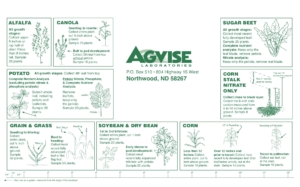Plant Sampling Basics – Sampling, storing, and shipping plant samples
Plant sampling season is in full swing. Agronomists submit plant samples for analysis for a number of reasons: to confirm visible nutrient deficiency symptoms, to detect “hidden hungers”, and to monitor or fine-tune fertilizer plans. For whatever reason you plan to take plant samples, here is a quick refresher on sampling, storing, and shipping plant samples to AGVISE Laboratories.
Sampling
Collecting the correct plant part is critical for interpreting plant analysis results. Make sure to identify the current plant growth stage and follow the directions for that specific crop and growth stage, displayed on the back of the AGVISE plant sample bag. Do you need AGVISE plant sample bags? You can request them here. If you are sampling a crop not listed on the plant sample bag, please call one of our laboratories for instructions.
Plant sampling instructions on the back of AGVISE Laboratories plant sample bag. Please use an AGVISE Laboratories bag to submit plant samples for analysis. We send them to AGVISE customers at no charge. Request them here.
Collect the number of plants or leaves indicated in the instructions. This ensures you have a good sample and that we have enough plant material at the laboratory to analyze. About 2 cups of plant material are typically enough.
Roughly 2 cups of plant material (above) are what we require to complete the laboratory analysis.
Storing – Plant Sample Care
- Brush off excess soil from plant material before placing it in the bag.
- PLEASE use AGVISE plant sample bags to submit samples. The backside has the required submission form.
- If you do not have an AGVISE plant sample bag, use a paper bag with holes poked in for ventilation.
- DO NOT use plastic bags. Plastic bags trap moisture, increasing the likelihood of plant material decomposition during storage and transit.
- If you are unable to ship plant samples to the laboratory immediately, store them in a refrigerator (do not freeze).
- It is okay for plant samples to sit outside of a refrigerator in a ventilated bag.
- Ensure all plant samples have your AGVISE account number in the submitter section. If you do not have an account number, please include your name, phone number, and address on the sample bag.
Shipping – United States Customers
United States customers can send their plant samples to either AGVISE laboratory. Shipping addresses for both are listed at the end of this webpage. You can ship samples to us via your preferred parcel carrier (e.g. USPS, UPS, FedEx, Spee-Dee, etc.). The sooner the sample arrives at the laboratory after being collected, the better. If you are sending multiple samples together in a box, do not pack samples too tightly in the box; leave room for some airflow.
Shipping – Canadian Customers
Canadian customers can drop off plant samples at any of the four Manitoba AGVISE dropbox locations: Portage la Prairie, Carman, Altona, or Winkler (see location info here). During the summer, the AGVISE route truck picks up samples from these locations on Tuesdays, Thursdays, and Saturdays. It is best to place your sample(s) in the dropbox the night before the route truck is scheduled. As long as the plant sample bag is ventilated, the sample will be okay sitting in the dropbox overnight. Samples dropped off in Winkler and Portage la Prairie can be placed inside refrigerators at the dropbox locations.
If you are located farther away from the Manitoba dropbox locations, please send your plant samples by Purolator ONLY to AGVISE Laboratories, 380 Kimberly Road, Winkler, MB R6W 0H7.
Additional information on sampling, storing, and shipping plant samples to AGVISE Laboratories can be found in the AGVISE Plant Sampling Guide.
Please contact us if you have any questions on plant sampling and analysis or need any supplies.








